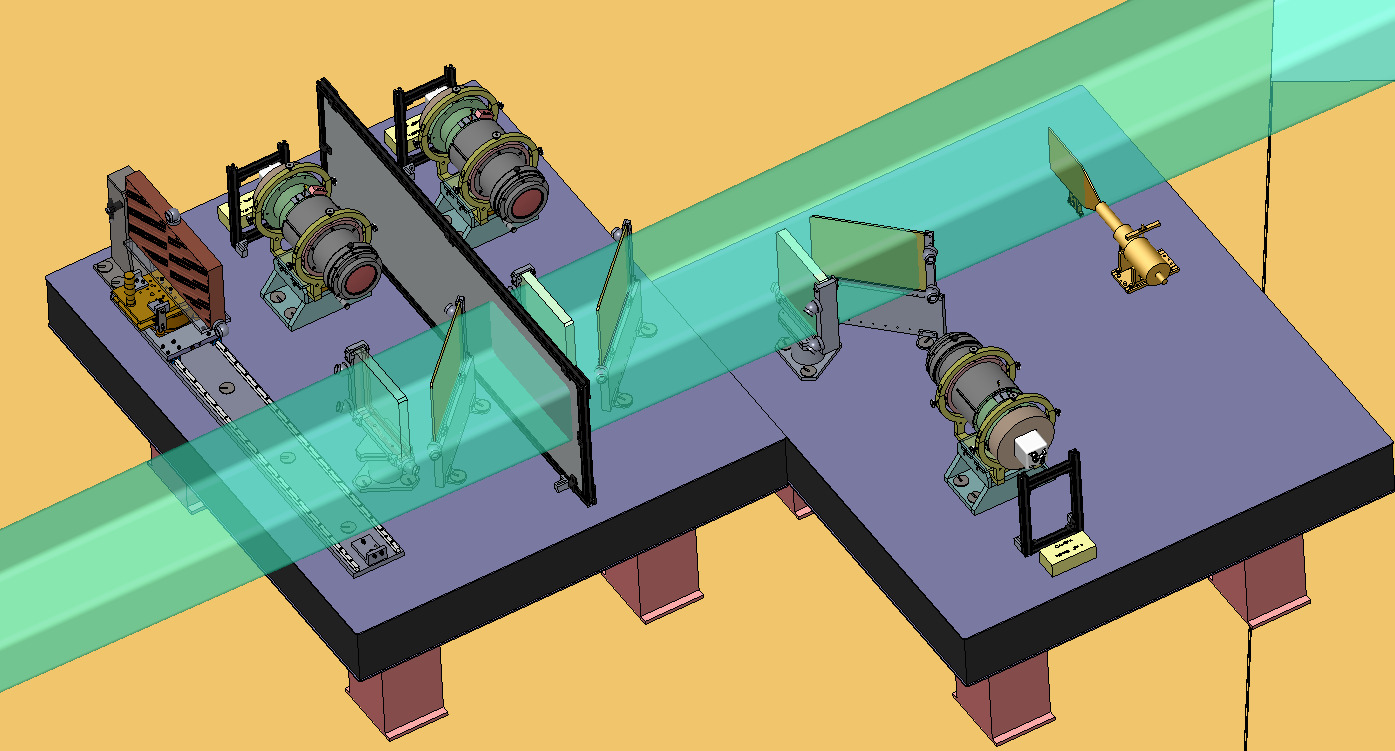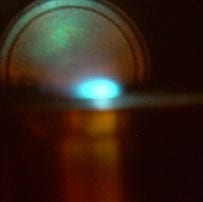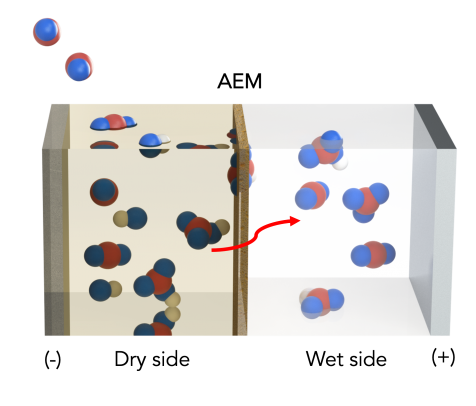
The neutron imaging setup, also used in the experiments, allows for three-dimensional imaging of the hotspot and cold fuel, providing critical information about the performance and symmetry of the experiments.
Burning plasma achieved in inertial fusion experiments for the first time
For more than 60 years, scientists have sought to understand and control the process of fusion, a quest to harness the vast amounts of energy released when nuclei in fuel come together. A paper published today in the journal “Nature” describes recent experiments that have achieved a burning plasma state in fusion, helping steer fusion research closer than it has ever been to its ultimate goal: a self-sustaining, controlled reaction.
Los Alamos National Laboratory researchers, including members of the Physics division, contributed essential capabilities in diagnostic science to achieve and analyze the unprecedented results. Their diagnostic advances helped transition fusion research to its current era at the threshold of ignition — the point at which a fusion reaction generates more energy than it receives and can burn on its own.
“These experiments indicate a transition to a different physics regime,” said Los Alamos physicist Hermann Geppert-Kleinrath, a member of the team at the National Ignition Facility working on the burning plasma project. “The research described in this paper marks where alpha heating in the reactions outcompeted the loss between radiation and heat conduction. It’s an exciting time because we’re at the point where continued marginal gains in how we conduct our experiments will lead to exponential improvements.”
The laser inertial confinement fusion experiments took place at the National Ignition Facility at Lawrence Livermore National Laboratory in California. Within a specially constructed cavity, a carbon-formed capsule, about one millimeter in diameter, contains both cryogenically frozen deuterium-tritium and the same as gas mixture — the fuel. When the cavity is heated with lasers, an x-ray bath results and warms the capsule until the fuel inside is compressed. The resulting fusion of the deuterium and tritium nuclei releases neutrons and alpha particles; the latter deposit their energy back into the hotspot of the reaction and in so doing contribute to the propagation of the burn. Such an alpha-dominated reaction is sought after as a key element in self-sustaining fusion.
Extreme forces require special capabilities
The forces at work in fusion are extreme. In the experiments described in the Nature paper, the temperature during the fusion reaction is about three times hotter than the center of the sun. The length of the reaction is incredibly short, too, approximately 130 picoseconds — the time it takes light to travel just four centimeters (light travels at 300,000 kilometers per second).
“It’s an unbelievably tough physics regime to do measurements on,” said Geppert-Kleinrath. “We’re essentially creating a miniature sun in the laboratory.”
In order to capture meaningful data from that event, Los Alamos researchers contributed several key diagnostic capabilities for the National Ignition Facility, each containing immense technical challenges. Hermann’s team is responsible for the gamma reaction history diagnostic, providing bang time (the time of maximum compression and reaction rate — also called stagnation) and burn duration. The gamma reaction history instrument measures reactions with time resolution down to ten picoseconds — a tiny timescale on which light only travels millimeters.
Physicist Verena Geppert-Kleinrath, team leader for advanced imaging at Los Alamos, led the neutron imaging capabilities that provided three-dimensional hot spot shapes for the National Ignition Facility experiments. (Coincidentally, Verena is married to Hermann.) Neutron imaging meant measuring a 70-micron hotspot — equal to the thickness of a human hair — from 30 meters away through an extended aperture with openings only a few microns wide.
“We’re very proud that coming from different fields and different groups within physics we have the privilege of being part of this very momentous achievement together,” said Verena Geppert-Kleinrath. “Los Alamos’ physics teams have been able to provide unique diagnostics to show the markers that we are looking for under challenging conditions.”
Improvements make progress toward fusion
Ultimately, the experiments explored the criteria for ignition — how fusion can be generated, and how it can be generated in such a way that it propagates itself, releasing more energy from the fuel than the energy it took to start the reaction courtesy of the lasers. The experiments and the analysis of the results suggested gradual improvements that could keep more energy inside the reaction instead of being lost to radioactivity or heat conduction. For instance, the fuel fill tube’s size was identified as a performance limitation through 3D neutron imaging, and future experiments used a specially engineered fill tube that was much smaller.
The four experiments or “shots” represented significant accomplishments in achieving burning plasma. The fourth shot saw more energy created than was lost due to radiation or heat conduction and likely may have achieved propagation had the capsule not disassembled in the implosion. The total energy output, including the laser energy to start the reaction, was still a net negative, but the clear improvement represented a tipping point toward self-sustaining fusion.
The gradual improvements paid off significantly in August 2021, when an experiment at the National Ignition Facility achieved a yield of 1.3 megajoules — an eight-fold increase over the experiments described in the Nature publication. While falling just short of one definition of ignition, the experiment suggests that fusion research has entered a new era, with further gradual improvements perhaps able to achieve ignition and self-sustaining fusion.
“We’re right at the cliff of experiments fizzling out versus experiments going into the ignition regime,” said Hermann Geppert-Kleinrath. “Once you transition into this regime where alpha heating is dominating, marginal gains in how we do the experiment lead to very large gains in yield.”
Original Article: New experiment results bolster potential for self-sustaining fusion
More from: Los Alamos National Laboratory | Lawrence Livermore National Laboratory
The Latest Updates from Bing News & Google News
Go deeper with Bing News on:
Self-sustaining controlled reaction
- FitSpresso Reviews – Scam or Not? (Update) Side Effects, Expert Analysis, Ingredients, and Real Customer Testimonials
With key insights into how its blend of Capsicum Annum, Panax Ginseng, and other potent ingredients synergize to aid in sustainable weight loss ... with a healthcare professional if severe reactions ...
- The Powell paradox: How the Fed chair’s words keep interest rates higher for longer
The Federal Reserve must closely monitor the impact of its public statements on market expectations and price levels, adjusting its communication strategy accordingly.
- Stormy Daniels Describes Sexual Encounter With Trump and Is Grilled by His Lawyer
After two witnesses walked jurors through the financial records at the heart of the case against Donald J. Trump, there are only a few major figures left for prosecutors to call.
- New biocontrol beetles for aggressive wetland weed – Expert Reaction
The Environmental Protection Authority has approved the import and release of four insects in the Manawatū-Whanganui region to control the spread of purple loosestrife, an invasive wetland weed.
- Undergraduate Research in Chemistry Guide
At the undergraduate level, research is self-directed work under the guidance and supervision ... intense work and the rest may be spent simply monitoring the progress of a reaction or an instrumental ...
Go deeper with Google Headlines on:
Self-sustaining controlled reaction
[google_news title=”” keyword=”self-sustaining controlled reaction” num_posts=”5″ blurb_length=”0″ show_thumb=”left”]
Go deeper with Bing News on:
Self-sustaining fusion
- An 'artificial sun' achieved a record-breaking fusion experiment, bringing us closer to clean, limitless energy
WEST, a fusion reactor in France, broke a record for tungsten tokamaks with a 6-minute plasma. It's an important step toward clean, limitless energy.
- Earth Radio takes the stage at Pyramid Scheme for an otherworldly album release show
Earth Radio's album release at the Pyramid Scheme was an immersive journey into jazz fusion. With captivating visuals and poetic lyrics, they explored themes of environmentalism and collaboration.
- Fusion–fission hybrids revisited
Each fission reaction releases a huge amount of energy (about 200 MeV) but requires a chain reaction for the reactor to remain self-sustaining. By comparison, a fusion reactor generates an ...
- Creating an island paradise in a fusion reactor
Creating an island paradise in a fusion reactor Date: April 16, 2024 Source: DOE/Princeton Plasma Physics Laboratory Summary: In their ongoing quest to develop a range of methods for managing ...
- US, Japan Team Up for Commercialization of Fusion Energy
In 2022 the U.S. claimed a breakthrough in research to achieve a self-sustaining nuclear fusion in which the mass lost in the reaction could be converted into large amounts of energy, a state of ...
Go deeper with Google Headlines on:
Self-sustaining fusion
[google_news title=”” keyword=”self-sustaining fusion” num_posts=”5″ blurb_length=”0″ show_thumb=”left”]










